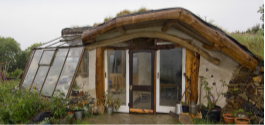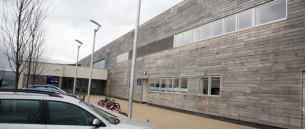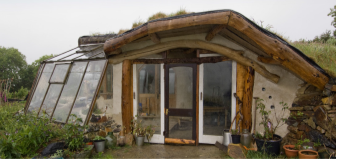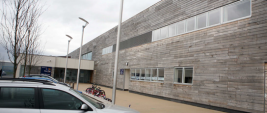Our environment: "Let’s go green!"
The lesson “Let’s go green”
Lesson objectives: In this lesson, students focus on some interesting and unusual buildings in the UK that have been designed with the environment in mind, helping them understand the importance of eco-friendly technology, recycling and sustainability.
Level: A2
Procedure
1. Introduction
Today’s topic is “Let’s go green”. And you will learn about unusual buildings in the UK which are eco-friendly you will be able to understand the importance of eco-friendly technology.
1.1. Warmer
Write the following adjectives on the board and ask students to tell you their meaning:
eco-friendly ecological environmentally-friendly green
Elicit that all four adjectives have the same meaning: they are all four ways to describe causing less harm to the world we live in. Ask students to name some ways in which we can protect our environment from harm.
Suggested answers
- recycle products
- use sources of renewable energy, e.g. wind, sunlight, etc.,
- turn off electrical devices when you finish using them
- walk or cycle to school instead of using cars or buses
- take shorter showers and turn off the tap when brushing teeth to save water
- choose to receive mail electronically to save paper
1.2 Look at the photos and describe the buildings. Is there anything unusual about them? (Students look at the photos and describe the buildings)


1.3 Vocabulary work
These words are all related to today’s lesson topic. You’ll work in pairs and try to guess the meaning of these words.
architect [n]: a person who designs buildings
award-winning [adj]: someone or something that has won a prize
drainpipe [n]: a pipe on a building that carries rainwater from the roof to the ground
eco-friendly [adj]: friendly to the environment
experiment [n]: an occasion to test a new idea or activity and find out the result
feature [n]: an important part of something
flush [v]: make water pass through a toilet
habitat [n]: the place where a particular animal or plant lives or grows
harmless [adj]: not dangerous
impressive [adj]: something to admire because it is very good or shows great skill
insulation [n]: material used to prevent heat, cold, noise or electricity from passing through something
skylight [n]: a window in a roof or ceiling
solar panel [n]: equipment that uses energy from the sun to create power for a building
straw [n]: yellow stems of dried crops, such as wheat
supply [n]: a quantity of something that is available to use
up-to-date [adj]: including the most recent or modern information, ideas or knowledge
weird [adj]: strange or unusual
Before reading the text again, ask students to find the words in the Vocabulary focus box in the text.
2 The main part
2.1 Reading
Read the text. List four ways in which these buildings are friendly to the environment.
Suggested answers
built with natural and recycled materials, grass roofs mean better insulation to keep buildings warm in winter and cool in summer, solar panels are a good source of energy, skylights and large windows allow more natural light into buildings, thick walls and windows help reduce heat loss, wind turbines are a good source of energy
Let’s go green!
Nowadays, architects are building more and more eco-friendly buildings in the UK for people to live, work and study in. Let’s look at a weird and wonderful eco-home in Wales and an award-winning eco-school in England and see how they’re making our future greener.
The Hobbit House 
In rural Wales, there’s an eco-village with nine houses in it. They all use the most up-to-date green technology and environmentally-friendly designs. The Hobbit House is one of them. With its round structure, grass roof and hillside location, it actually looks like the home of the famous hobbit, Bilbo Baggins!
The house uses natural and recycled materials, like wood, stone and mud. It has straw in the floor, walls and roof for insulation. Plastic sheets and mud on the roof keep out the rain. The grass on the roof also insulates the building, keeping it warm in winter and cool in summer. The roof has features such as solar panels to provide energy and
skylights to bring in natural daylight too.
There’s a living room, a bedroom, a bathroom and a kitchen with a fridge that keeps cool, thanks to a supply of cold air from under the house. The building is a really impressive structure and its design means it’s very good for the environment because it causes hardly any pollution. There aren’t many homes like it at the moment, but hopefully
there will be in the future.
The eco-friendly school 
Howe Dell primary school in Hatfield is doing an experiment to make its building harmless to nature. For the pupils, helping the environment is very important and they do everything they can to be green. This includes going to school on foot and developing fingerprint technology to replace library cards in order to save paper.
The design of the school includes thick walls and windows to reduce heat loss and large windows to bring in lots of light. Solar panels heat the water in the bathrooms and canteen, and a wind turbine provides electricity. The roof is covered in plants that provide insulation and it’s also a living classroom for pupils to study the natural habitat of insects in biology lessons.
The school is always thinking of new ways to be eco-friendly: it has toilets that flush rainwater, sinks made from recycled plastic yoghurt pots and desks made of drainpipes! It really is an example of what other schools should be like. It’s important to be green for our future, and it’s often the small changes that make a big difference.
2.2. Read the text again. Then read the sentences and decide which building(s) they describe. Circle ecohome (H), eco-school (S) or both (B).
1 The grass roof insulates the building. H / S / B
2 Insulation for the building includes straw and mud. H / S / B
3 There are solar panels to provide energy. H / S / B
4 Wind energy provides power. H / S / B
5 The building will cause very little pollution. H / S / B
6 Recycled rainwater is used in this building. H / S / B
Answers: 1 H 2 H 3 B 4 S 5 B 6 S
2.3. Match the features of the buildings with their purpose (1–5).
desks made from drainpipes • grass large windows • plastic sheets • mud • rainwater • skylights • solar panels • straw • thick walls • thick windows • wind turbines
1 provide energy solar panels solar panels
wind turbines
2 provide insulation
3 stop rain entering
4 use recycled materials
5 provide natural light
Answers:
1 provide energy solar panels solar panels
wind turbines
2 provide insulation straw, grass, thick walls, thick windows
3 stop rain entering plastic sheets, mud
4 use recycled materials rainwater, desks made from drainpipes
5 provide natural light skylights, large windows
DID YOU KNOW?
There are some eco-friendly buildings around the world with unusual designs, such as a home in Avila, Spain which is made from four empty shipping containers and a home on a farm in Arizona, USA that is made from empty grain silos! Eco-homes like these are both cost-effective and energy-efficient!
2.4. Discuss the questions in pairs.
1 Do you know any eco-friendly buildings in your town or city? If so, what types of buildings are they? Describe them.
2 Do you think eco-buildings are a good idea? Why/Why not?
3. Summing – up
3.1. Home assignment
Prepare a project about the eco-friendly house of the future.
3.2. Reflection
I hope this material was interesting for you. What have you learned today? Thank you for your work.

про публікацію авторської розробки
Додати розробку
